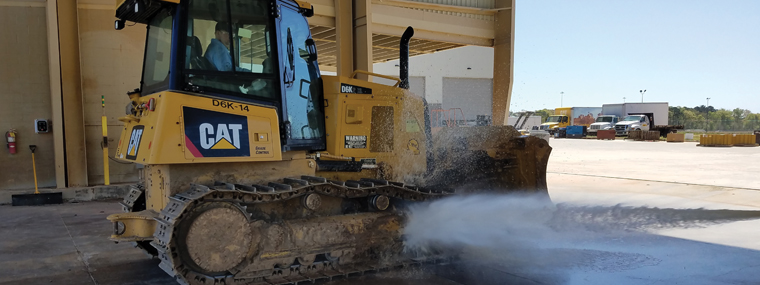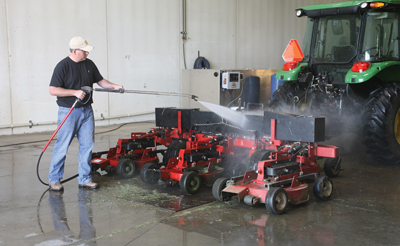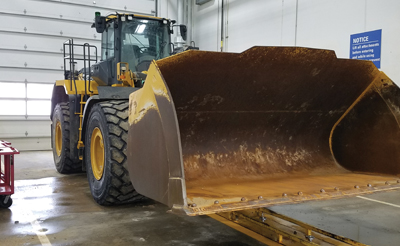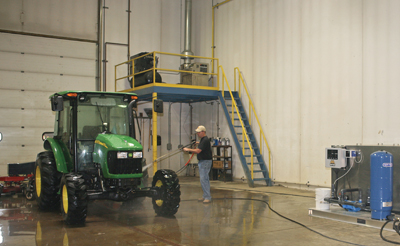
Selling Water Treatment Systems
By Diane M. Calabrese / Published May 2019

M
agic and Water…Poets and Dreamers Often Link the Two
Magic and water treatment? An entirely different matter. Precision in system design is the foundation for an excellent water treatment system. No one can dream a path to that.
“No two applications are alike,” explains Aaron Auger, water treatment division manager at Mi-T-M Corporation in Peosta, IA. “I often say that we may start with page number two of the catalog, but more often than not we need to customize some aspect to fit the customer’s needs.
“This is where the design and engineering of the project come into play,” continues Auger. “Giving the customer the right fit is the first step in making sure the right system is designed for that application.”
How important is it to understand the end user’s expectations and plans for use when selling a water treatment system? “The question may be better phrased as how important it is to educate the end user as to what they can expect to get when implementing a water treatment system,” says Auger.
“A lot of customers whom I speak with are very educated but some are not,” explains Auger. “It’s our job as sales people to let them know the limitations of a recycle system and what maintenance needs to take place in order to ensure the best results. Part of that process is giving them the right type of treatment system and the correct size, along with the proper wash pad design.”
Customers may have wishful notions about water treatment systems. Pointing out the wishful part is part of selling.
“When I hear someone say, ‘out of sight, out of mind,’ I typically come back with ‘what goes in must come out,’” says Auger. “A lot of people just assume that they can wash everything into a pit and the reclaim system will take care of it. Not so. This again is where proper design of the wash pad and pit system makes all the difference to ensure that the water treatment system does what it is supposed to do, which is to treat water.”
Interesting applications are to be found in every industry. Auger says that he has “been fortunate to have worked on a number of unique projects” throughout his career with his company.
“From golf courses around the world to some of the largest names in the equipment manufacturing industry, we have put a lot of water treatment systems into some pretty unique situations,” says Auger. “From a simple oil/water separator to erecting an entire building to house a wash bay as a part of a multi-million dollar project, no two customers’ needs are the same. That’s what keeps my job fresh and always interesting.”
Clarify the Doable
“Qualifying the customer’s expectations is of utmost importance,” says Bernie Larson, application specialist with Water Maze® in Camas, WA. “It begins with qualifying the application in terms of water volumes, influent wash water characteristics, and the effluent water quality requirements in terms of the intended use of the treated water.
 “Next is educating the customer in terms of the capabilities and limitations of certain water treatment technologies that are capable of achieving the water quality requirements,” continues Larson. “Last but not least is to confirm if the customer’s expectations in terms of acquisition budget and maintenance budget is on par with what can be achieved.”
“Next is educating the customer in terms of the capabilities and limitations of certain water treatment technologies that are capable of achieving the water quality requirements,” continues Larson. “Last but not least is to confirm if the customer’s expectations in terms of acquisition budget and maintenance budget is on par with what can be achieved.”
And it means dispelling the biggest misconceptions. Larson says there are three top misconceptions:
“One—‘All water treatment systems are equal.’ Not true. There are various water treatment technologies. In many cases, in order to meet the site-specific water quality requirements, multiple water treatment technologies must be employed.
“Two—‘Wash water can be recycled for an extended period of time.’ Not true. The length of time that treated water can be recycled is directly related to the processed water quality, which is directly related to the applied water treatment technology. In other words, the better the treatment system performs, the better the water quality, and the longer you can recycle the water.
“Three—‘If you have a city sewer, a POTW [publically-owned treatment works] connection that services your property, you can discharge wash water to the sewer.’ Not true. You must apply to the POTW before discharging wash water. In some cases, the local POTW has reached their capacity limits and will not accept wash water discharge.”
Enormous Need
“Old Mother Earth has the same amount of water, but everyone is using more than ever,” says Roy G. Chappell, CEO of Chappell Supply and Equipment in Oklahoma City, OK.
Treatment will have to become a priority in every sector, explains Chappell. “This business of selling water treatment systems is going to double or triple in the next few years.”
 Among those who will be expected to routinely incorporate water reclamation to allow treatment are power washing contractors. “Pressure washer users must get up to speed,” says Chappell. Yet the need for systems already extends from owner/operators who use pressure washers to large companies.
Among those who will be expected to routinely incorporate water reclamation to allow treatment are power washing contractors. “Pressure washer users must get up to speed,” says Chappell. Yet the need for systems already extends from owner/operators who use pressure washers to large companies.
When working with a company to help it remove waste from effluent, understanding customer expectations is a must. “That’s one of the most important parts of selling water treatment equipment, and that’s where a majority of companies fail,” says Chappell.
“Once you know what expectations are, you need to run an effluent test,” explains Chappell. With the effluent test results, a seller will be able to determine whether a successful treatment can be devised or not. “Some effluent waste streams you just have to walk away from.”
Chappell adds a corollary: The seller should analyze effluent, even if the customer presents test results. Too often, prospective customers have old tests—as many as several years old. The composition of waste in effluent can change over time as processes at the business change.
Fitting a system to a need requires a look at many factors. “One, you need to find out how many gallons per hour or gallons per day are flowing, so you can size your equipment,” says Chappell. “We try to size 20 to 25 percent higher.” The assumption is the company will continue growing and eventually require the additional capacity.
Education is part of every step of the discussion and ultimate design. For example, it may be necessary to put a peristaltic pump in to counter suds, which in themselves can cause anxiety, says Chappell.
The analytics—what the composition of the effluent is and what the composition of the effluent must be after treatment—is where it all begins. Knowing what’s in the effluent will determine how the effluent must be handled, from microbes to attack oils to filters for particulates.
Chappell says that he sees two fundamental misunderstandings about water treatment systems among prospective customers. “One, they think you’re just going to throw a piece of equipment in and it will treat from then on.”
But the waste stream might change. Chappell tells customers they will have to recheck the waste stream once a year and has them sign an agreement to make such a check. To initially get the optimal settings in place, checks must be made several times a day.
 The other misunderstanding Chappell sees stems from a system that works so well it lures company employees into a sort of magical thinking. The trench of a system must never become a dumping ground for liquids that should go to a specialized collector. For starters, such liquids can stop the treatment system from functioning.
The other misunderstanding Chappell sees stems from a system that works so well it lures company employees into a sort of magical thinking. The trench of a system must never become a dumping ground for liquids that should go to a specialized collector. For starters, such liquids can stop the treatment system from functioning.
What might be dumped? Antifreeze for one, and this is a problem because it kills microbes that are in the system to break down oils.
The antifreeze dumping may be vexing, but it’s really another problem to solve. “We have developed enzymes to break down antifreeze in case it is dumped,” says Chappell.
Chappell’s company is accustomed to taking on challenges. It completed a large proprietary project in Canada for a customer in need of a closed system. And it did so under such high security that no cell phones or photos were permitted on site and pass codes kept changing.
Essential Details
Water treatment hinges on being able to ascertain what’s in water prior to treatment and what’s there after treatment. The Environmental Protection Agency (EPA) promulgates the approved tests for measuring chemical and biological pollutants. (See www.epa.gov/eg.) EPA also establishes allowable amounts of chemicals, microbes, and biosolids in water that has been treated. Discharge standards are developed on an industry-by-industry basis.
The National Pollution Discharge Elimination System (NPDES) authorized by the EPA (under the Clean Water Act) regulates permitting for treatment and pretreatment. NPDES entities—generally a state or region—perform permitting and enforcement regarding discharges to surface waters. Publicly-owned water treatment facilities may issue their own guidance in support of the goals of the state or regional NPDES authority.
See the February 2017 Cleaner Times article, titled “Putrefaction Keeps the Earth a Pleasant Place” (www.cleanertimes.com/magazine/cleaner-times-articles-2/putrefaction-keeps-earth-pleasant-place), for more on goals of treatment and the paths that wastewater may take.
Control of pollutants—the aim of the treatment of water—is built on a rigorous scientific method. No magic necessary.





